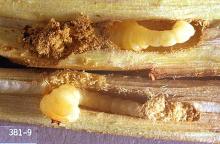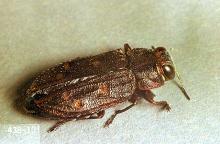Includes
Pacific flatheaded borer (Chrysobothris mali)
Flatheaded apple tree borer (Chrysobothris femorata)
Pest description and crop damage These flatheaded borers are pests of many different trees and shrubs, including most fruit trees. Adults are metallic, oval and flattened. Flatheaded apple tree borer are greenish bronze-colored and are the larger species, with adults typically measuring 0.35 to 0.63 inch in length. Pacific flatheaded borers are typically the more destructive species in the PNW, and adults are reddish-bronze beetles with copper-colored spots on wing covers, and are about 0.25 to 0.5 inch long. Larvae of both species are legless, whitish to pale yellow and about 0.5 inch in length when fully developed. Just behind the head is a broad, flat enlargement giving a "flat-headed" appearance. Larvae feed beneath the bark and may girdle the trunks and branches of trees. Young, recently planted trees can be very susceptible to girdling by these pests. Trees that are stressed because of drought or suffering sunburn or sun scald on the trunks are particularly susceptible to attack. Apple trees are sometimes attacked at the graft union.
Biology and life history The insects overwinter in host plants as mature larvae. In spring, they pupate and then bore "D" shaped emergence holes in the tree. Some borers may spend more than one season in tree trunks. They emerge usually from late May through August. Females lay eggs from June through July in crevices in the bark, usually on the sunny side of tree trunks below the lowest branches. Stressed trees are the preferred egg-laying site. The larvae hatch, burrow into the wood, and feed on the cambial and vascular tissues until full grown. Burrows are characteristically broad and irregular.
Scouting and thresholds Watch for swellings under bark on young trees or cracks through which frass may be seen. Fine sawdust frass piles may be evident around the base of infested trees.
Management-biological control
Birds peck the larvae from under the bark with their beaks. Some wasp parasites attack the borer. Carpenter ants eat both larvae and pupae from the wood. Harvest mites attack pupae inside the pupal chambers.
Management-cultural control
Beetles are attracted to weakened, sunburned, or injured parts of the trunk and lay eggs in cracks on bark exposed to the sun. Protect young and newly planted trees from sunburn by whitewashing or painting with white interior latex paint. Paper trunk protectors or shading the trunk with boards also may be helpful. Avoid drought stress and nutrition deficiency on young trees. Remove infested trees where practical to reduce pest pressure.
June through July sprays
Management-chemical control: HOME USE
- azadirachtin (neem oil)-Some formulations are OMRI-listed for organic use.
- imidacloprid-Soil drenches may have residual activity in woody plants lasting for 12 or more months. If short-term management is the goal, consider other approaches.
- pyrethrins-Highly toxic to bees. Some formulations are OMRI-listed for organic use.
- zeta-cypermethrin-Highly toxic to bees.
Management-chemical control: COMMERCIAL USE
Management strategies include use of trunk sprays or systemic materials.
- fenpropathrin (Danitol 2.4 EC) at 16 to 21.3 fl oz/A in up to 100 gal water per application. Do not exceed 42.7 fl oz/A per season. Highly toxic to fish, bees, and wildlife. REI 24 hr. PHI 14 days. [Group 3A]
- imidacloprid (Admire Pro and generics) at 7 to 10.5 fl oz/A chemigation or root drench, depending on label. Do not apply prior to bloom or when bees are actively foraging. Do not apply more than 10.5 oz product/A per growing season. REI 12 hr. PHI 21 days.



